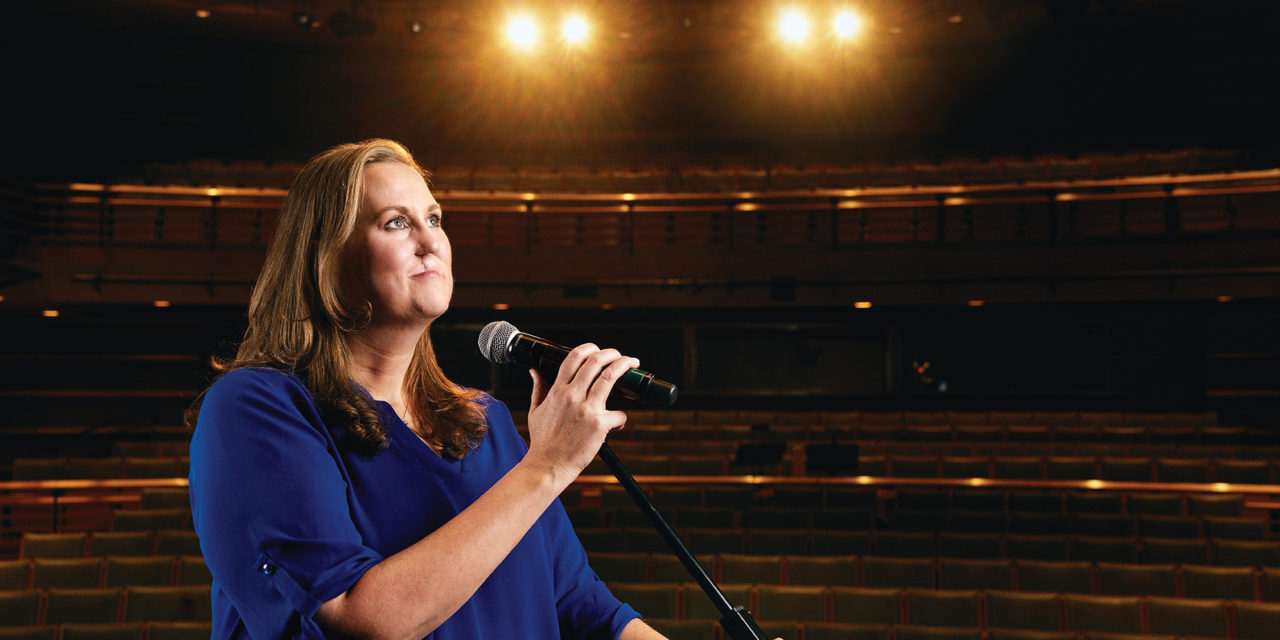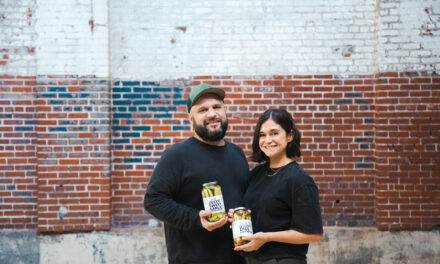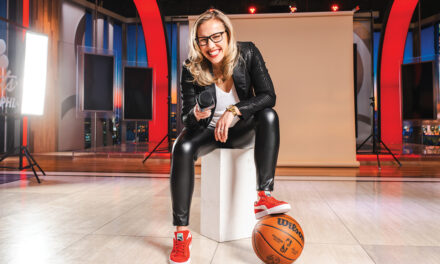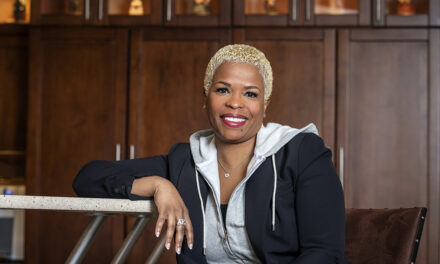She was coming into her own as a performer when cancer in her mouth resulted in seven surgeries and the altering of her face forever. But her voice and her spirit are stronger than ever.
When Kaytie O’Hara sings, her whole faces changes. All the new shapes, scars, and shadows from her cancer are replaced by resplendent joy and ease, and she loses herself in the moment and the music. Her voice is silky and strong, without a hint of the fear or uncertainty that wracked her body and mind over the past 3 years as she fought for her life.
At 40, O’Hara moves through the world with a new face, one marred by the removal of her upper jaw—first one half and then the other—to stay ahead of osteogenic sarcoma, a rare bone cancer. After facing down life-threatening cancer, she is more grateful for life than resentful of her new reality. (“If a facial deformity is the worst thing I have to deal with, then I can do that,” she says.) But in the years since she was first diagnosed, it has taken a lot to get here, both in terms of fighting cancer and finding the courage to show her new face to the world.
As the words flow so effortlessly from her mouth—the source of so much anguish—it’s easy to forget all that she’s been through at such a young age. But when you spend a moment to really take in the face before you and the woman behind it, the songs she sings mean so much more.

I knew I was going to have to get the surgery I had been avoiding. I told the doctor, Take it all. I don’t care if I never sing again or what I look like. Take my ears if you need to. I just want to live.

Head and neck cancers don’t have a ribbon or a month. I wish I had someone to call who I could have asked what it’s like when you wake up from surgery and you’re missing part of your face.
“They think I have bone cancer.”
O’Hara grew up in Fort Washington, Pa. and graduated from Penn State with a degree in family studies with a minor in music and vocal performance, but she spent her 20s in San Francisco, far from the Broadway lights she always wanted to pursue. She was a personal assistant, which eventually led her to work at a Global Peace Conference in Indonesia with Nobel Peace Prize Laureate Archbishop Desmond Tutu. “I went there to change and grow and really just to live. And I’m so glad I took the time to do that in my 20s because stuff doesn’t stop exploding in your life as you get older,” she says. “But I moved to New York because I was ready to dive into performing.”
Trying to pursue a career on stage in Manhattan was a grind, but after years of feeling like she was spinning her wheels and struggling to find her identity as a performer, Kaytie began landing opportunities that had alluded her initially, such as quality voiceover work. “Auditioning in New York City is no joke, but I did some cabaret, and I worked with amazing voice teachers,” she says. “I was auditioning in front of well-connected people. Even when you’re not getting parts, being in front of people really counts, and that was finally starting to happen.”
But then something else happened in 2013 that would change her life forever. A lump began to grow on her gum (“like someone had taken a marble and cut it in half”), and it continued to increase in size fairly quickly. “I was self-conscious about it. The dentist said we’d keep an eye on it. They sent me to an oral surgeon who assured me that these things happen. They shaved it off, and that was that.”
But a year later, it came back. The oral surgeon shaved it off again and biopsied the sample. The results were so startling that he thought there must be a mistake. “I had a message from him, and I called him right back. I was standing in Michael’s crafts, and he said, ‘I want you to know I think this is a misdiagnosis. It’s coming back as an osteogenic sarcoma of the maxilla. It doesn’t make any sense to me that it’s in your face. It’s so rare,’” she says. “I hung up the phone and called my mom. I was hyperventilating crying. I said, ‘They think I have bone cancer.’ She was very steady on the phone. She was like ‘Ok, we don’t know anything yet—just come home.’”
Osteogenic sarcoma was a shocking diagnosis, since the average age at diagnosis is 15 years old, and it’s typically found in bones in the upper arms, thighs, or shins; not in the mouth of a 37-year-old woman. But test results confirmed the diagnosis, and O’Hara was soon facing surgery to amputate part of her jaw where the tumor was located and replacing it with a denture-like prosthetic called an obturator. “My teeth were starting to hurt—that’s how fast it was growing. They were 99 percent sure I had cancer, but they believed it was low grade. Initially, they didn’t think I was going to need chemo,” she recalls.
In November 2014, right before Thanksgiving, surgeons removed the right half of her upper jaw and gave her the prosthesis, which, once all the swelling went down, made her face look almost completely normal. But once all the imaging was returned, the doctors discovered that there was still more cancer and that she was going to need more surgery and chemotherapy, all of which were incredibly difficult for O’Hara to endure. “I had six cycles of chemo over 4 months. I was completely flattened and in the hospital for the majority of it,” she says. “But one bright spot was my head-shaving party in New York with friends. We drank champagne and sang show tunes. There was so much love and laughter but with respect to what was happening.
It was one of the most beautiful nights of my life.”
“The cancer was back. I just knew.”
After two surgeries and six rounds of chemotherapy, the cancer was in remission, but the doctors warned O’Hara that the cancer had a high chance of returning unless they removed her entire jaw. “But at that time, I just didn’t feel like I could give myself a facial deformity for life in case the cancer came back,” she says. “I got a second opinion, and we felt that as long as we watched it very closely, it would be ok.”
As O’Hara embarked on the healing process and returned to New York, she eventually found the courage to test out her voice, knowing there was no guarantee it would sound the same or have the power it once did. “A few weeks after my first surgery, I started to hum in the shower. My hum sounded the same, and when I started to sing, my voice was still there. I didn’t know if I’d have the power, but I knew I would sing again.”
But then, a year after her first surgery, on the day before Thanksgiving, O’Hara took out her mouthpiece and, to her horror, she felt a bump on the other side of her gum. “We were getting ready to have Thanksgiving dinner, and I didn’t want to upset anyone. But I told my mom, ‘I think it’s back, and now I have to have the surgery I had been avoiding,’” O’Hara recalls. “I told the doctor, ‘Take it all. I don’t care if I never sing again or what I look like. Take my ears if you need to. I want to live.’” She knew this would result in a lifelong facial deformity, so she took 10 days to get her life in order and try to come to terms with the enormity of what she was facing.
O’Hara went into the hospital on December 15, 2015, for the surgery, which required the removal of her jaw and her fibula in her left leg, which the surgeons used to make a new jaw. She was in the hospital for 10 days with a feeding tube. They took care to protect O’Hara’s vocal chords, but she really had no idea of what her face would look like or how her voice would sound after the surgery. This time, the recovery was as intense physically as it was emotionally. Since the degree to which her face would be deformed was somewhat unknown before surgery, she and her mom discussed whether or not to cover the mirrors in the house, at least initially. “She thought it could be too traumatic for me to see myself. But I said no because it would have been denying reality. Covering mirrors wasn’t going to change how I looked, and I needed to get used to it,” Kaytie says. “I used the bathroom the day after surgery, and I looked in the mirror for the first time. I was swollen and gross, but I remember thinking, Ok, this is doable. I am glad reconstruction is an option, but, if there wasn’t, I could live with this.”
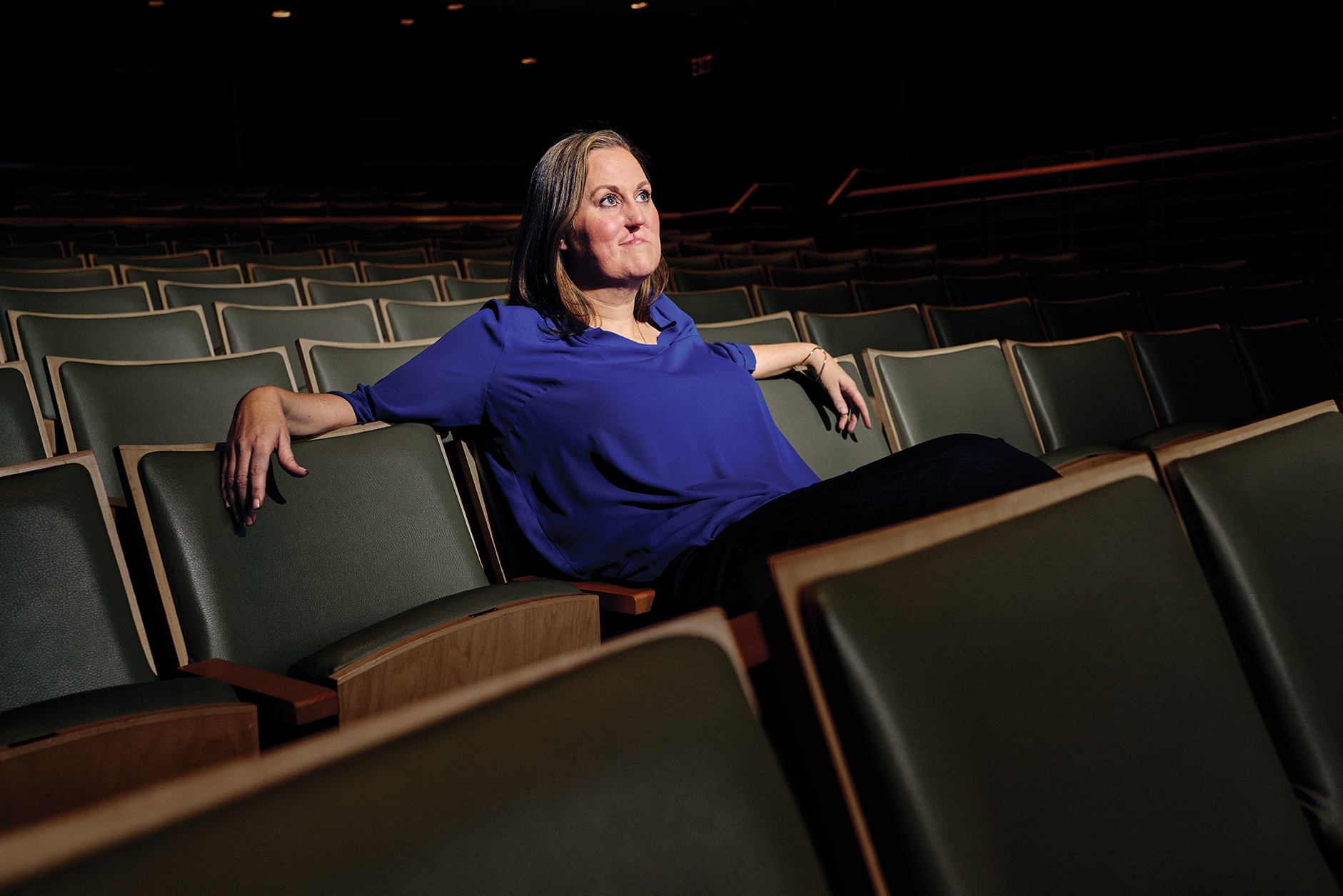
Kaytie O’Hara was shot at the Perelman Theater at the Kimmel Center in Philadelphia.

Fly Like an Eagle
On October 8, O’Hara performed the national anthem before the Philadelphia Eagles game at Lincoln Financial Field. “There were things that happened that I can hardly even believe. Eagles quarterback Carson Wentz came up and high fived me! It was incredible walking around and seeing people who were clearly in treatment and having them stand up for me. This one woman physically couldn’t stand. I just ran up to her, and I said, ‘You got this.’ And all she could do is just nod. That’s when it hit me, and I got emotional. I remember thinking, This is such important work, and I get to do it. I was that woman. I couldn’t move. I needed my mother to put my pajamas on. But it really does get better. What a gift. The next day I got a call from a casting agent. I didn’t get the role, but just to have the opportunity. It was incredible.”
For people to take a moment they wouldn’t have before to say ‘I’m really grateful for what I have’ makes everything so worth it.
“I can still do what I love. That hasn’t been taken away.”
Months after her face-changing surgery, O’Hara still wasn’t wholly comfortable in public. She recalls abandoning grocery carts and panicking over a posted picture on Facebook. But a good friend, Kelli O’Hara (no relation), a Tony-award winning singer and actress was performing a concert at the Merriam Theater in Philadelphia, and she invited Kaytie O’Hara and her family to come. So, Kaytie decided to bring one of her most beloved nurses who had been there through the worst of the cancer treatment.
She got a text from Kelli who asked her if she would consider performing a song during her concert. When Kaytie responded that she wasn’t ready, Kelli told her to think about it. A few days before the concert, the massacre at the Pulse nightclub in Orlando, in which 49 people were killed, gave the idea new life. “I thought, Who cares about my face. It felt like it was a calling at that point. I decided to sing Wonderful World,” O’Hara says. “I went to sound check with Kelli, I sang my heart out, and we both cried.”
O’Hara’s friends and family attended the concert, but only her mom knew she planned to sing. “When Kelli called me up, my family gasped. She talked about me and what I’d gone through, and she said, ‘Your face changes, but you know what doesn’t change? Your heart and your vocal chords. Listen to this.’ It was a sacred moment, and people were on their feet before I’d finished the song.”
Since singing that song at the Merriam, O’Hara has performed somewhat regularly, including at the Concert for America at her alma mater Penn State to raise money for non-profits and at a Philadelphia Eagles game in October where she sang the national anthem in front of 70,000 people and a national television audience. While she still faces insecurities and why-me moments, several experiences at her performances solidified the influence she could have over people who are in the midst of their own cancer battles. “After the Concert for America, a woman came up to me and told me it was her first day of chemo. She said, ‘I didn’t want to come to this concert tonight, but now I know I was supposed to be here and meet you.’ That made everything I’d been through have so much meaning,” she recalls. “For people to take a moment they wouldn’t have before to say ‘I’m really grateful for what I have’ makes everything so worth it.”
O’Hara’s struggle to come to terms with her face is still a daily challenge, but it gets better all the time, as she has the chance to use her voice to speak (and sing) to the world. Not only has she become an advocate for health care and head and neck cancers, but O’Hara is also speaking to young people about bullying. She wants to do more performing and public speaking, and she’s thinking of writing a book. She wants to use her platform to raise awareness about some of the challenges cancer patients face but seldom discuss, including financial strains and the lack of attention for the mental health of cancer patients during the healing process. But through it all, she never loses sight that she was fortunate to survive and thankful for the people in her life who helped her do it.
“I feel grateful to be above ground. I just lost a friend who I met during chemo. She was young and had kids. Her cancer ended up in her spinal cord, and she passed away in August. I think of her every day,” O’Hara says. “It’s not a picnic—I can hardly feel my hands and feet from the neuropathy, and people still stop and stare at my face. But I’m here. So I’ll figure out how to deal with it and maybe change a few minds out there.”

